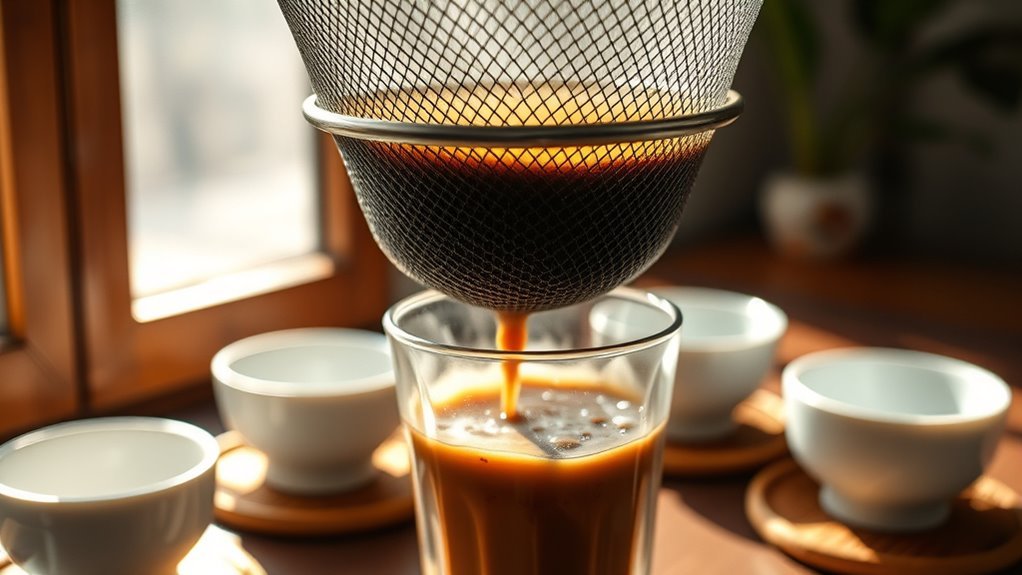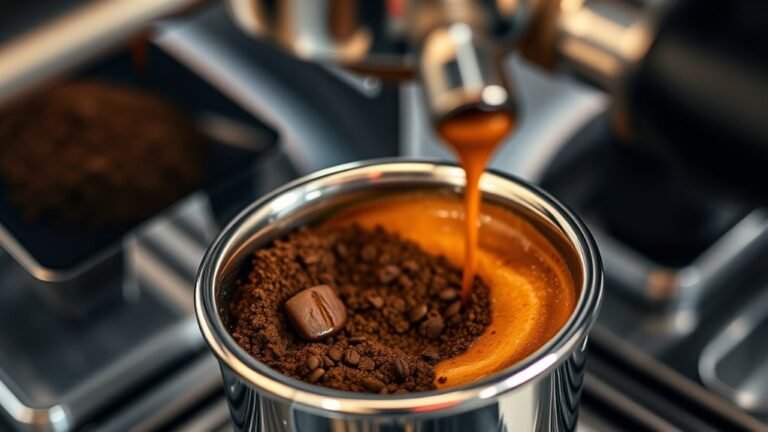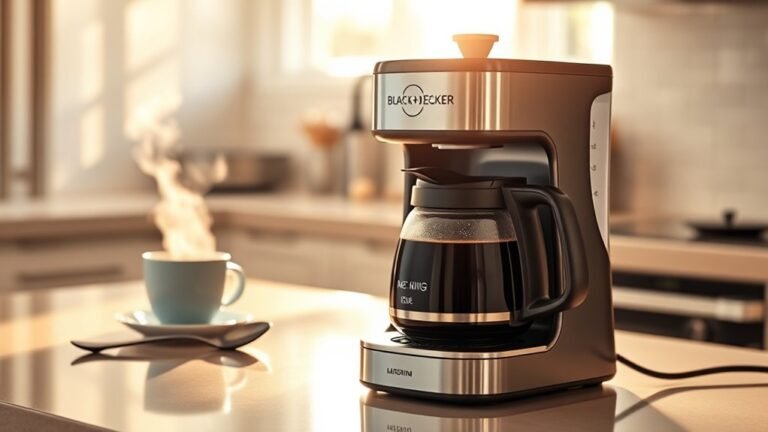The Art of the Vietnamese Phin Filter
You’ll love how the Vietnamese Phin filter turns coffee brewing into a slow, sensory ritual. This simple, sturdy device lets hot water drip through rich, dark grounds, revealing deep, bittersweet flavors and intoxicating aromas. As you watch the steady drip, you connect with Vietnam’s heritage and savor a moment of calm in your busy day. From choosing the perfect beans to mastering the gentle press, there’s so much more to explore in this timeless art.
History and Origins of the Vietnamese Phin Filter

Although you might not have noticed it, the Vietnamese phin filter carries a rich history that dates back to the early 20th century. As you hold it, you connect with a tradition born from simplicity and resilience, capturing the essence of Vietnamese daily life. Its cultural significance goes beyond brewing coffee; it symbolizes a slow, mindful ritual amid rapid change. The phin’s design, humble yet effective, spread globally, influencing coffee culture far beyond Vietnam’s borders. You can almost taste the bold, robust flavors steeped through each drip, a sensory representation of freedom—the freedom to savor, to pause, and to embrace heritage. This small filter, with its global influence, invites you to experience a world where tradition meets modernity in every cup.
Components of a Traditional Phin Filter
When you hold a traditional Phin filter, you’ll notice its simple yet sturdy design, often made from stainless steel or aluminum. Each part—the brewing chamber, the perforated press, and the lid—plays a key role in extracting that rich, aromatic coffee. Understanding how these components work together helps you appreciate the slow, dripping process that makes Vietnamese coffee so unique.
Phin Filter Material Types
A traditional Vietnamese phin filter is crafted from a few simple yet carefully selected materials that work together to create your perfect cup of coffee. Commonly, stainless steel, aluminum, and sometimes even ceramic are used. Stainless steel offers excellent filter durability, resisting rust and warping, making it ideal for daily use. Aluminum, lighter and often more affordable, heats up quickly but may wear down faster over time. Ceramic phins, though less common, provide a unique aesthetic and retain heat well but require gentle handling. When comparing materials, think about your lifestyle: do you need something rugged for travel or a stylish piece for your kitchen? Understanding this materials comparison helps you choose a phin that not only brews delicious coffee but also matches your freedom to brew wherever you desire.
Essential Phin Filter Parts
The heart of your Vietnamese phin filter lies in its essential parts, each designed to work in harmony for that rich, slow-drip coffee experience. You’ll find a brewing chamber where the grounds rest, paired with a perforated press that gently tampers the coffee to your brewing preferences. A lid sits atop, preserving heat and aroma as the water slowly seeps through. The base plate, often with tiny holes, supports the filter over your cup. This thoughtful phin filter design empowers you to control extraction speed and strength, revealing bold flavors unique to Vietnamese coffee. Knowing these components lets you appreciate the freedom to customize each cup, transforming simple ingredients into an artful, sensory ritual that awakens your senses with every drip.
Function of Each Component
Every component of the traditional Vietnamese phin filter plays an essential role in crafting your perfect cup of coffee. The brewing chamber holds your coffee grounds, where the magic begins. The perforated press sits atop, gently compressing the grounds to control water flow, directly impacting brewing efficiency. The lid traps heat, ensuring consistent extraction, while the filter plate with tiny holes allows water to drip slowly, coaxing rich flavors out. Finally, the drip tray collects excess liquid, keeping your setup tidy. Understanding each component’s function lets you fine-tune the process, revealing the full sensory experience of Vietnamese coffee. This harmony of parts gives you freedom to savor bold aromas and smooth texture, making every sip a moment of crafted indulgence.
Selecting the Right Coffee Beans for Phin Brewing
When you choose coffee beans for your Phin brewing, the flavor profile and roast level play essential roles in shaping the final cup. You’ll find that traditional Vietnamese coffee often uses dark roast profiles, which bring out bold, smoky notes that cling beautifully to the slow drip method. Exploring various coffee bean varieties—from robusta’s earthy, intense character to arabica’s bright, fruity nuances—gives you freedom to tailor your brew’s complexity. Dark roasts yield a rich, bittersweet intensity, while medium roasts offer a balanced sweetness with subtle acidity. By selecting beans that complement the Phin’s extraction style, you reveal layers of aroma and texture that make each sip a sensory escape. Remember, the right beans are your gateway to mastering the authentic Vietnamese coffee experience.
Step-by-Step Guide to Using a Vietnamese Phin Filter

You’ll start by carefully preparing the phin filter, warming it up and adding just the right amount of ground coffee. Then, you’ll slowly pour hot water, letting the rich aroma bloom as the coffee begins to drip through. Following these steps guarantees a smooth, flavorful brew that captures the essence of Vietnamese coffee.
Preparing the Filter
Although the Vietnamese phin filter looks simple, preparing it correctly is key to revealing its rich, aromatic brew. Start by rinsing the phin’s metal parts with hot water; this filter preparation step warms the equipment, ensuring an even extraction. Place the filter chamber on your cup, then add your chosen coffee grounds—medium-coarse is ideal. Gently level the grounds to create a flat surface, avoiding compacting them too tightly. Next, position the perforated press over the grounds, applying light pressure to hold everything in place. Each step forms the brewing essentials, setting the stage for that slow, mesmerizing drip that’s signature to Vietnamese coffee. Proper preparation frees you to enjoy a deeply satisfying cup, capturing the full essence of your coffee’s flavor.
Brewing Process Steps
As soon as your phin filter is assembled and set atop your cup, the brewing process begins with pouring hot water gently over the coffee grounds. This moment releases rich aromas, setting the stage to explore distinct flavor profiles. Follow these brewing techniques to reveal the phin’s full potential:
- Pour a small amount of hot water to let the grounds bloom, intensifying the aroma.
- Add more water slowly, allowing it to drip through—the pace controls strength.
- Watch the dark, dripping coffee gather below, its scent promising freedom in every sip.
- Once dripping stops, remove the filter, stir your coffee, and savor the bold, smooth taste.
With each step, you embrace a ritual that celebrates patience and the art of liberation through flavor.
The Science Behind the Slow Drip Process

When you watch the coffee slowly drip through a Vietnamese phin filter, you’re witnessing a delicate balance of time, temperature, and pressure at work. This slow extraction process allows hot water to percolate gently through the finely ground coffee, coaxing out complex flavors that quick brewing methods often miss. As each droplet falls, aromatic oils and rich compounds develop fully, creating a bold, smooth profile that’s uniquely Vietnamese. You can almost smell the deep, earthy notes mingling with subtle hints of chocolate and caramel. By controlling the drip rate, the phin filter gives you freedom to savor every nuanced layer of flavor, transforming a simple cup into a sensory journey. This slow drip isn’t just a technique—it’s the science that reveals coffee’s true soul.
Popular Vietnamese Coffee Recipes Using the Phin
Vietnamese coffee isn’t just about the brewing method—it’s also about the creative recipes that bring out its unique character. When you use the phin, you reveal a world of flavors that can be tailored to your mood and taste. Here are four popular ways to enjoy Vietnamese coffee with sweetened condensed milk:
Vietnamese coffee is more than brewing—it’s about creative recipes that unlock bold, velvety flavors to suit every mood.
- Cà phê sữa đá – Iced coffee with sweetened condensed milk, perfect for hot days.
- Cà phê trứng – Rich egg coffee blending creamy yolk with robust brew.
- Cà phê đá muối – Iced coffee with a pinch of salt and sweetened condensed milk for balance.
- Cà phê đen nóng – Hot black coffee sweetened naturally with condensed milk.
Each recipe lets you savor freedom in flavor, embracing bold, velvety textures and aromatic depth.
Tips for Cleaning and Maintaining Your Phin Filter
Though your phin filter might seem simple, keeping it clean is crucial to preserving the rich flavors and smooth texture of your coffee. Start by disassembling your phin after each use, rinsing all parts with warm water to remove residual oils and grounds. Avoid harsh soaps that can linger and alter your brew’s taste. For deeper cleaning, soak the filter in a mixture of vinegar and water to dissolve stubborn stains. Gently scrub with a soft brush to maintain the delicate mesh and perforations. Regular maintenance tips include drying your phin thoroughly to prevent rust and storing it in a dry, ventilated space. By embracing these cleaning techniques, you guarantee every cup delivers the authentic, bold experience you crave, freeing your senses with each sip.
Comparing the Phin Filter to Other Coffee Brewing Methods

How does the phin filter stack up against other coffee brewing methods you might be familiar with? When you explore brewing comparison, the phin advantages stand out in simplicity and flavor extraction. Unlike espresso machines or drip coffee makers, the phin offers a slower, more meditative process. Here’s how it compares:
- Espresso Machine – Quick and intense but requires electricity and precision.
- French Press – Bold flavors with full immersion, but the texture can be gritty.
- Pour-over – Clean and bright, yet demands a steady hand and specific equipment.
- Phin Filter – Portable, affordable, and delivers a rich, robust coffee with a slightly sweet finish.
With the phin, you’re free to savor each drop, embracing a relaxed ritual that connects you to tradition and your own pace.
Frequently Asked Questions
Can the Phin Filter Be Used for Tea Brewing?
You can definitely use the phin filter for tea brewing, and it’s a fantastic way to explore different tea varieties. This method lets you control the steeping time and water flow, revealing rich, layered flavors. Imagine the soothing drip and aroma filling your space as you experiment with loose leaf teas or herbal blends. This brewing technique gives you freedom to craft a personalized, sensory tea experience that’s both calming and invigorating.
What Is the Ideal Water Temperature for Phin Brewing?
Imagine steam swirling gently as hot water meets dark coffee grounds. For ideal brewing techniques, aim for water around 195-205°F (90-96°C). This temperature releases rich flavor extraction without bitterness, letting you savor each drop’s bold aroma and smooth taste. When you control the heat just right, your brew becomes a liberating ritual, freeing your senses and delivering that perfect, balanced cup every time.
How Long Does a Typical Phin Brew Take?
A typical phin brew time usually takes about 4 to 6 minutes, depending on your grind size and water temperature. When you master the phin technique, you’ll notice the slow, steady drip creating a rich, aromatic cup. This leisurely process lets you savor each moment, freeing you from rush and routine. As the coffee blooms and darkens your cup, you’ll feel a sense of calm, making the wait part of the pleasure.
Are There Phin Filters Made From Materials Other Than Metal?
Imagine catching sunlight in your hands—that’s the feeling of brewing with a ceramic phin, smooth and earthy, letting you savor each drip like a slow dance. Yes, there are phin filters beyond metal; bamboo phins, for example, bring a natural, rustic vibe to your ritual, connecting you to nature’s pulse. Choosing these materials lets you break free from convention, crafting coffee that’s as unique and adventurous as you are.
Can a Phin Filter Be Used on Induction Cooktops?
You can absolutely use a phin filter on induction cooktops, but you’ll need a magnetic base to make it work since induction cooktops heat through magnetic fields. If your phin filter is made of stainless steel that’s compatible with induction, you’re set. Imagine that slow, rich drip of coffee, warming your senses as freedom fills your kitchen. Just guarantee the phin filter sits steadily on the cooktop, and you’ll enjoy that authentic brew effortlessly.






